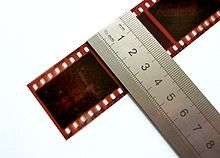35mm format


The 35 mm format, or simply 35 mm, is the common name for the 36×24 mm film format or image sensor format used in photography. It has an aspect ratio of 3:2, and a diagonal measurement of approximately 43 mm. It has been employed in countless photographic applications including single-lens reflex (SLR) cameras, rangefinder cameras (film and digital), mirrorless interchangeable-lens digital cameras, digital SLRs, point-and-shoot film cameras, and disposable film cameras.
The format originated with Oskar Barnack and his introduction of the Leica camera in the 1920s.[1] Thus it is sometimes called the Leica format[2] or Barnack format.[3] The name 35 mm originates with the total width of the 135 film, the perforated cartridge film which was the primary medium of the format prior to the invention of the full frame DSLR. The term 135 format remains in use. In digital photography, the format has come to be known as full frame, FF or FX, the latter invented as a trade mark of Nikon. Historically the 35 mm format was sometimes called miniature format[4] or small format,[5] terms meant to distinguish the it from the medium and large formats.
Invention
The 35 mm format was conceived by Oskar Barnack by doubling the size of the 24×18 mm format used in cinema.[1]
Use in still photographic film cameras
The term 35 mm camera usually refers to a still photographic film camera which uses the 35 mm format on 135 film. Such cameras have been produced by Leica, Kodak, Nikon, Canon, Minolta, Olympus, Contax, Pentax, Carl Zeiss, Fujifilm, and numerous other companies. Some notable 35 mm camera systems are the original Leica, Leica M, Leica R, Nikon F, Canon FD, Canon EOS, Minolta OM, Pentax "K" mount system, Minolta Maxxum/Dynax "A" mount system, and the intercompatible Contax and Yashica (C/Y) systems.
Use in digital cameras

Many digital image sensors approximate the dimensions of the 35 mm format, sometimes differing by fractions of a millimeter on one or both dimensions. Since 2007, Nikon has referred to their 35 mm format by the trade mark FX. Other makers of 35 mm format digital cameras, including Leica, Sony, and Canon, refer to their 35 mm sensors simply as full frame.
Lenses
A true normal lens for 35 mm format would have a focal length of 43 mm, the diagonal measurement of the format. However, lenses of 43 mm to 60 mm are commonly considered normal lenses for the format, in mass production and popular use. Common focal lengths of lenses made for the format include 24, 28, 35, 50, 85, 105, and 135 mm. Most commonly, a 50 mm lens is the one considered normal, any lens shorter than this is considered a wide angle lens and anything above is considered a telephoto lens. Even then, wide angles shorter than 24 mm is called an extreme wide angle. Lenses above 50 mm but up to about 100 mm are called short telephoto or sometimes, as portrait telephotos, from 100 mm to about 200 mm are called medium telephotos, and above 300 mm are called long telephotos.
Focal length equivalent
Many photographers think about angle of view in terms of 35 mm format lenses, due to the historic prevalence of the 35 mm format. For example, a photographer might associate a 50 mm focal length with a normal perspective, because a 50 mm lens produces that perspective on this format. With many smaller formats now common (such as APS-C), lenses may be advertised or marked with their "35 mm equivalent" or "full-frame equivalent" focal length as a mnemonic. This 'equivalent' is computed by multiplying (a) the true focal length of the lens by (b) the ratio of the diagonal measurement of the native format to that of the 35 mm format.
For example, a lens for APS-C format (18×24 mm) with a focal length of 40 mm, might be described as "60 mm (35 mm equivalent)." Although its true focal length remains 40 mm, its angle of view is equivalent to that of a 60 mm lens on a 35 mm format (24×36 mm) camera. Another example is the lens of the 2/3 inch format Fujifilm X10, which is marked with its true zoom range "7.1–28.4 mm" but has 35 mm-equivalent zoom control markings ranging from "28" to "112".
Other Formats
Medium format is generally the next step up, with 120 film or a larger medium format sensor gathering more information and detail. Medium format is higher quality because of the larger negative or sensor size, but also more expensive and less portable. Medium format cameras require a longer focal length lens to capture the same view as a 35 mm format camera. To illustrate this, a "normal" lens on a 35 mm camera has a focal length of approximately 50 mm, while a lens with a focal length of approximately 100 mm is needed for the same image taken on 120 film (6 cm x 7 cm format). Since depth of field decreases as focal length increases, a medium format camera has a shallower depth of field at the same f-stop as a 35 mm camera. Mamiya, Phase One, Hasselblad and Pentax are notable medium format brands.
Large format 4x5 and 8x10 cameras are popular among serious professional photographers for the high optical quality, even though the camera requires a tripod, longer exposure times, and much more expense. Ansel Adams is a notable large format photographer. Many photographers prefer the image quality of large format but the portability of 35 mm. Graflex and Linhof are notable large format brands.
References
- 1 2 The British Journal of Photography. 133: 1485. 1986.
- ↑ Camera 35. U.S. Camera Publishing Corp. 3–4: 34.
- ↑ Walter, Thomas (2005). Mediafotografie: analog und digital. Springer.
- ↑ Suess, Bernhard J. (October 1, 2003). Mastering black and white photography. Allworth Press. p. 11.
- ↑ Warren, Bruce (2003). Photography: A Concise Guide. Cengage Learning. p. 41.